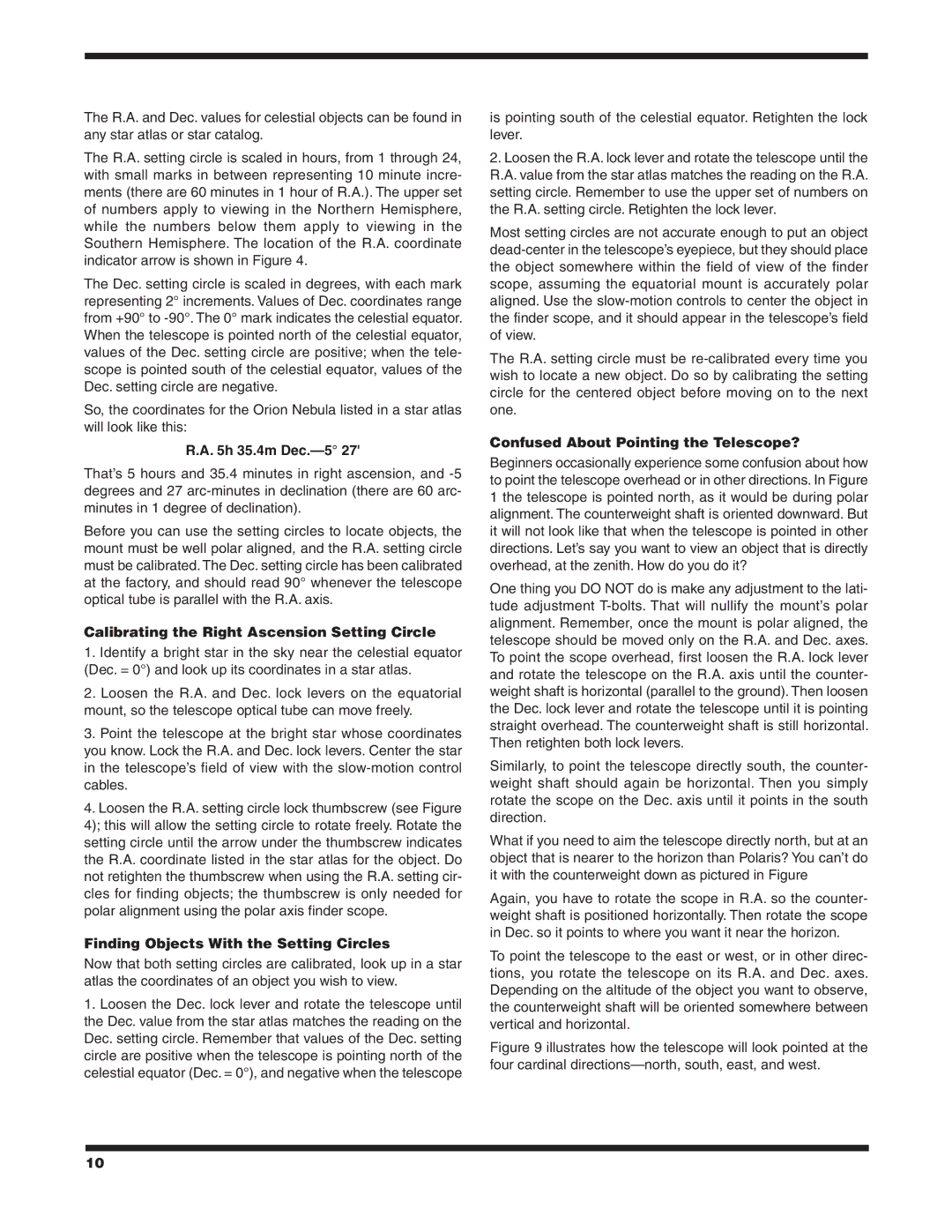
The R.A. and Dec. values for celestial objects can be found in any star atlas or star catalog.
The R.A. setting circle is scaled in hours, from 1 through 24, with small marks in between representing 10 minute incre- ments (there are 60 minutes in 1 hour of R.A.). The upper set of numbers apply to viewing in the Northern Hemisphere, while the numbers below them apply to viewing in the Southern Hemisphere. The location of the R.A. coordinate indicator arrow is shown in Figure 4.
The Dec. setting circle is scaled in degrees, with each mark representing 2° increments. Values of Dec. coordinates range from +90° to
So, the coordinates for the Orion Nebula listed in a star atlas will look like this:
R.A. 5h 35.4m Dec.—5° 27'
That’s 5 hours and 35.4 minutes in right ascension, and
Before you can use the setting circles to locate objects, the mount must be well polar aligned, and the R.A. setting circle must be calibrated. The Dec. setting circle has been calibrated at the factory, and should read 90° whenever the telescope optical tube is parallel with the R.A. axis.
Calibrating the Right Ascension Setting Circle
1.Identify a bright star in the sky near the celestial equator (Dec. = 0°) and look up its coordinates in a star atlas.
2.Loosen the R.A. and Dec. lock levers on the equatorial mount, so the telescope optical tube can move freely.
3.Point the telescope at the bright star whose coordinates you know. Lock the R.A. and Dec. lock levers. Center the star in the telescope’s field of view with the
4.Loosen the R.A. setting circle lock thumbscrew (see Figure 4); this will allow the setting circle to rotate freely. Rotate the setting circle until the arrow under the thumbscrew indicates the R.A. coordinate listed in the star atlas for the object. Do not retighten the thumbscrew when using the R.A. setting cir- cles for finding objects; the thumbscrew is only needed for polar alignment using the polar axis finder scope.
Finding Objects With the Setting Circles
Now that both setting circles are calibrated, look up in a star atlas the coordinates of an object you wish to view.
1.Loosen the Dec. lock lever and rotate the telescope until the Dec. value from the star atlas matches the reading on the Dec. setting circle. Remember that values of the Dec. setting circle are positive when the telescope is pointing north of the celestial equator (Dec. = 0°), and negative when the telescope
is pointing south of the celestial equator. Retighten the lock lever.
2.Loosen the R.A. lock lever and rotate the telescope until the R.A. value from the star atlas matches the reading on the R.A. setting circle. Remember to use the upper set of numbers on the R.A. setting circle. Retighten the lock lever.
Most setting circles are not accurate enough to put an object
The R.A. setting circle must be
Confused About Pointing the Telescope?
Beginners occasionally experience some confusion about how to point the telescope overhead or in other directions. In Figure 1 the telescope is pointed north, as it would be during polar alignment. The counterweight shaft is oriented downward. But it will not look like that when the telescope is pointed in other directions. Let’s say you want to view an object that is directly overhead, at the zenith. How do you do it?
One thing you DO NOT do is make any adjustment to the lati- tude adjustment
Similarly, to point the telescope directly south, the counter- weight shaft should again be horizontal. Then you simply rotate the scope on the Dec. axis until it points in the south direction.
What if you need to aim the telescope directly north, but at an object that is nearer to the horizon than Polaris? You can’t do it with the counterweight down as pictured in Figure
Again, you have to rotate the scope in R.A. so the counter- weight shaft is positioned horizontally. Then rotate the scope in Dec. so it points to where you want it near the horizon.
To point the telescope to the east or west, or in other direc- tions, you rotate the telescope on its R.A. and Dec. axes. Depending on the altitude of the object you want to observe, the counterweight shaft will be oriented somewhere between vertical and horizontal.
Figure 9 illustrates how the telescope will look pointed at the four cardinal directions—north, south, east, and west.
10
